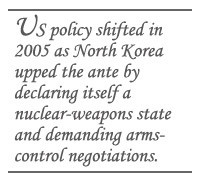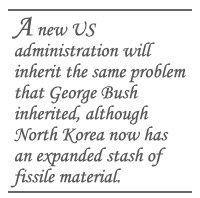Revisiting the “Axis of Evil” – Part II
Revisiting the “Axis of Evil” – Part II

WASHINGTON: North Korea’s nuclear-development efforts have bedeviled US policymakers for more than two decades, resulting in international crises during both the Clinton and George W. Bush administrations. With the end of the second Bush administration, it’s now possible to grade the handling of the current crisis in light of past efforts and understand the scope of the challenge confronting the next administration.
The Bush administration came into office with a Clinton-era 1994 Agreed Framework in place that had the appearance of freezing but not eliminating North Korea’s nuclear-development efforts. That agreement promised delivery of 500,000 tons of heavy fuel oil annually until completion of construction of two 1000-megawatt light water reactors in exchange for North Korea’s return to compliance with international safeguards under the International Atomic Energy Agency (IAEA) and Nuclear Non-Proliferation Treaty (NPT).

Construction of the reactors was originally envisioned to be completed in 2003, but delays in LWR construction meant that when the Bush administration came into office, it was still on the hook to deliver 500,000 tons of heavy fuel oil annually and the North had not yet resolved a dispute with the IAEA over whether North Korea might have reprocessed enough material for one or two nuclear weapons. However, as long as the agreed framework was in place, North Korea’s ability to produce plutonium remained contained.
Clinton administration critics had characterized the agreed framework as having kicked the can down the road – delaying a tough stance on North Korea’s nuclear program. Moreover, under the Clinton administration’s watch, North Korea covertly began to pursue uranium enrichment as an alternative route to plutonium reprocessing as a way to revive its nuclear-weapons development efforts.
The Bush administration’s foreign policy team came into office skeptical about the Clinton-era agreements with North Korea, with some officials eager to roll back the agreed framework. An ill-fated early meeting with President Bush embarrassed South Korea’s President Kim Dae Jung, who was rebuffed in his appeal to promote engagement with North Korea.
Following 9/11, the situation worsened. Although North Korea had no connection with 9/11, the Bush administration saw danger in North Korea’s combination of totalitarian rule and ongoing interest in nuclear weapons and long-range missiles. Along with Iran and Iraq, North Korea was enshrined as a charter member of the “Axis of Evil” in the 2002 State of the Union speech.

The trigger for the second North Korean nuclear crisis was rising concern that North Korea had received assistance from Pakistan’s A.Q. Khan network in pursuit of a covert highly enriched uranium program in violation of the agreed framework. North Korean officials initially admitted, then denied, the existence of the program during the visit of US special envoy James Kelly in October 2002. Following these revelations, the crisis escalated rapidly as the US cut deliveries of heavy fuel oil through the Korean Peninsula Energy Development Organization to North Korea. North Korea responded by withdrawing from the NPT, reprocessing plutonium stored following the 1994 shutdown of the Yongbyon reactor and resuming operation of the reactor to expand its fissile-materials inventory.
The Bush administration supported the establishment of the Six Party Talks – including North Korea, South Korea, Japan, Russia, the US and China – in 2003. Bush characterized North Korea’s pursuit of nuclear weapons as a “regional problem” and announced the objective of “comprehensive, verifiable, irreversible dismantlement.” But the administration forbade bilateral US-DPRK meetings at the Six Party Talks, resulting in a virtual stalemate through 2004.
Bush administration policy shifted in early 2005 as North Korea upped the ante by declaring itself a nuclear-weapons state and demanding arms-control negotiations. Although the administration rejected those North Korean positions, Kelly’s successor, Christopher Hill, was authorized to conduct bilateral talks with the North Koreans within the six-party framework. Hill led intense negotiations that resulted in the September 19, 2005, Six Party Joint Statement, which essentially envisioned a grand bargain: North Korea would denuclearize in exchange for economic assistance, establishment of a permanent peace regime and diplomatic normalization with the US and Japan.

A US Treasury announcement made only days prior to the announcement of the Joint Statement targeted a Macao-based bank under Section 311 of the US Patriot Act for facilitating North Korean money-laundering and counterfeiting. That resulted in North Korea’s decision to boycott negotiations. The stalemate lasted for more than a year, until North Korea conducted missile and nuclear tests in July and October 2006. These tests drew universal condemnation in the form of two UN resolutions, the second of which imposed but fell short of implementing stiff economic sanctions.
The nuclear test also catalyzed a last-ditch round of diplomacy that resulted in North Korea’s return to the Six Party Talks in December 2006. That meeting led to a secret round of US-DPRK talks in Berlin that set the framework for a February 13, 2007, six-party implementing agreement in which North Korea pledged to disable its nuclear facilities and submit a “complete and correct” declaration regarding its nuclear program with the initial phase—disabling the Yongbyon facilities and “discussing” the list of its nuclear programs occurring within 60 days in return for delivery of the first 50,000 of an eventual 1 million tons of heavy fuel oil or equivalent and a US pledge to begin delisting North Korea from the US terrorist list and repeal the Trading With the Enemy Act.
However, after 18 months, the Bush administration decided to move first in exchange for a North Korean limited declaration that omitted reference to the alleged uranium-enrichment program or alleged proliferation of nuclear technology to Syria. It’s up to Bush’s successor to finish the job of denuclearizing North Korea.
The Bush administration failed to contain North Korea’s covert nuclear developments in its first term, ironically choosing policies that facilitated its capacity to expand a small nuclear arsenal. Although the second administration has gained commitments in principle from the North to achieve full denuclearization, implementation to date has resulted in a situation in which North Korea’s capacity to expand its nuclear arsenal is “frozen” – or under the Bush agreement, “disabled.” North Korea’s denuclearization remains an aspiration – not an accomplishment.
Thus, a new US administration will inherit essentially the same problem that the Bush administration inherited, although North Korea now has an expanded stash of fissile material at its disposal. Although North Korea’s capacity to make more materials is contained and the next administration will not face immediate crisis, it’s urgent that the next administration make clear that a nuclear-capable North Korea will not stand as part of a new status quo in Northeast Asia.

The successive and bipartisan policy failures of the past two decades illustrate that any conclusive deal with North Korea will likely be accompanied by buyer’s remorse. The best strategy for achieving North Korea’s denuclearization, as politically unpalatable as it may be in Washington, will be to affirm that the foundational principles embodied in the September 19, 2005, Joint Statement still stand as an attainable objective and promote concrete efforts toward full implementation of those goals.
This means both insisting that North Korea fully implement its denuclearization obligations by strengthening coordination among regional partners to compel North Korea’s denuclearization through both word and actions while actively pursuing a diplomatic relationship with a denuclearized and normalized North Korea. Such an approach should recognize that the existence of a relationship is the prerequisite for pursuing progress on even harder issues and should require that North Korea’s viability depends on its ability to conduct “normal” economic and political relations on a give-and-take basis rather than relying for survival on handouts from its Northeast Asian neighbors.
Scott Snyder is a senior associate with The Asia Foundation and Pacific Forum CSIS. The views expressed here are personal views. He can be reached at ssnyder@asiafound-dc.org.